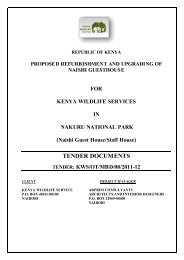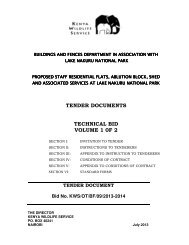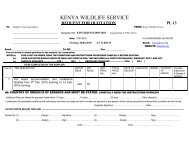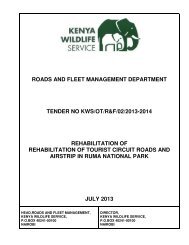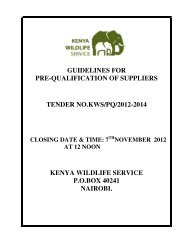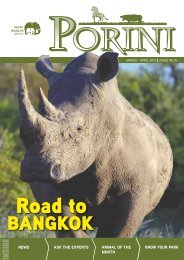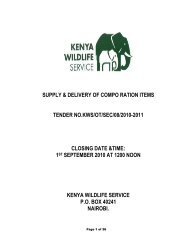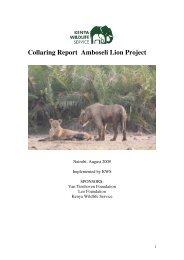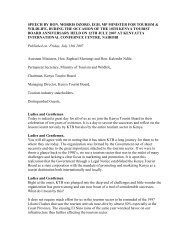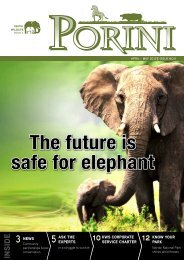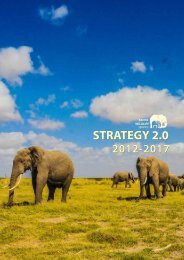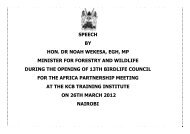Conservation and Management Strategy for the Elephant in Kenya
Conservation and Management Strategy for the Elephant in Kenya
Conservation and Management Strategy for the Elephant in Kenya
You also want an ePaper? Increase the reach of your titles
YUMPU automatically turns print PDFs into web optimized ePapers that Google loves.
CONSERVATION AND MANAGEMENT STRATEGY FOR THE ELEPHANT IN KENYA xii<br />
[ LEFT ] Plate 8.<br />
Adult female with her young a a waterhole. Samburu National Reserve, <strong>Kenya</strong><br />
- Renaud Fulconis. Awely, Wildlife <strong>and</strong> People<br />
[ BELOW ] Plate 9.<br />
A large Amboseli bull <strong>in</strong> musth guard<strong>in</strong>g two females <strong>in</strong> oestrus<br />
- Cynthia Moss, Amboseli Trust <strong>for</strong> <strong>Elephant</strong>s<br />
Home-range: Area utilised by an elephant or family group of elephants; depend<strong>in</strong>g on <strong>the</strong> productivity of <strong>the</strong> region,<br />
it may be as small as 14 km2 (e.g. at Lake Manyara, Tanzania) or as large as 3500 km2 (<strong>in</strong> arid country, such as <strong>the</strong> desert of NW<br />
Namibia).<br />
Human-<strong>Elephant</strong> Conflict [HEC]: Any human-elephant <strong>in</strong>teraction which results <strong>in</strong> negative effects on human<br />
social, economic or cultural life, on elephant conservation or on <strong>the</strong> environment.<br />
Immobilization: Term used to describe <strong>the</strong> chemical or physical restra<strong>in</strong>t of an animal.<br />
Indicator (of success): A s<strong>in</strong>gle measure of achievement or a description of <strong>the</strong> conditions to show that a particular<br />
Action had been implemented successfully. Good <strong>in</strong>dicators are measurable, precise, consistent <strong>and</strong> sensitive.<br />
Indigenous: Orig<strong>in</strong>at<strong>in</strong>g <strong>and</strong> liv<strong>in</strong>g or occurr<strong>in</strong>g naturally <strong>in</strong> an area or environment.<br />
Invasive Alien Plant Species [IAPS]: Non-<strong>in</strong>digenous <strong>in</strong>troduced plants which are capable of <strong>in</strong>creas<strong>in</strong>g beyond<br />
a local area.<br />
Ivory: Material of which elephant tusks are composed (mostly dent<strong>in</strong>e). It is used <strong>in</strong> <strong>the</strong> manufacture of a great<br />
variety of objects usually of an ornamental nature.<br />
Juvenile: A sub-adolescent <strong>in</strong>dividual elephant: often divided <strong>in</strong>to young juvenile (2–5 years old) <strong>and</strong> old juvenile<br />
(5–10 years old).<br />
Keystone Species: A species that has major ecological effects on its habitat <strong>and</strong>, <strong>the</strong>re<strong>for</strong>e, on o<strong>the</strong>r species liv<strong>in</strong>g<br />
<strong>in</strong> <strong>the</strong> same area. <strong>Elephant</strong>s are second only to humans <strong>in</strong> <strong>the</strong> alteration of <strong>the</strong>ir habitat: e.g. by feed<strong>in</strong>g <strong>the</strong>y may<br />
change bush to grassl<strong>and</strong>, by digg<strong>in</strong>g <strong>for</strong> water <strong>the</strong>y provide dr<strong>in</strong>k<strong>in</strong>g places <strong>for</strong> o<strong>the</strong>r animals, etc.<br />
Loxodonta africana: African elephant; divided <strong>in</strong>to 2<br />
sub-species: Savannah elephant L. a. africana <strong>and</strong><br />
Forest elephant L. a. cyclotis.<br />
Miombo: In East, Central, <strong>and</strong> South-central Africa, a type<br />
of mixed woodl<strong>and</strong> of trees <strong>and</strong> shrubs, dom<strong>in</strong>ated by<br />
broad-leafed, deciduous trees of <strong>the</strong> genera<br />
Brachystegia <strong>and</strong> Julbernardia.<br />
Mortality: Referr<strong>in</strong>g to loss <strong>in</strong> a population; <strong>in</strong>cludes<br />
factors such as disease, accidents, starvation, predation<br />
<strong>and</strong> poach<strong>in</strong>g.<br />
Natality: Referr<strong>in</strong>g to <strong>the</strong> birth-rate <strong>in</strong> a population:<br />
usually 3–5% per year <strong>in</strong> a healthy elephant population.<br />
Objective: Broad summaries of <strong>the</strong> approaches to be<br />
taken <strong>in</strong> attempt<strong>in</strong>g to achieve a strategy’s Vision <strong>and</strong><br />
Goals. Each objective usually refers to a logically related<br />
set of threats <strong>and</strong> constra<strong>in</strong>ts; <strong>for</strong> example, if lack of<br />
capacity was identified as a constra<strong>in</strong>t on effective<br />
conservation of a species, <strong>the</strong>n one obvious objective<br />
would be to develop capacity.



